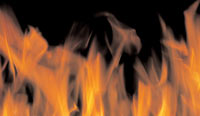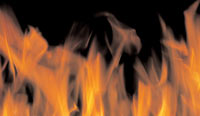
A Burning Need
A scalable, two-wire fire system protects federal, state facilities
- By Beth Welch
- Apr 21, 2008
 The protection of life and
property within government
facilities nationwide
requires a proven
solution that’s flexible,
yet cost-effective. Using the E3 Series®
emergency evacuation system by
Gamewell-FCI, two facilities—different
in both form and function—got all the
protection they required.
The protection of life and
property within government
facilities nationwide
requires a proven
solution that’s flexible,
yet cost-effective. Using the E3 Series®
emergency evacuation system by
Gamewell-FCI, two facilities—different
in both form and function—got all the
protection they required.
It's In the Mail
The Postal Service Processing and
Distribution Center in Dallas is part of a
national network of mechanized bulk
mail centers that process first-class letters
and parcels. Employees at the
439,959-square-foot facility sort and
route an average of 4.3 million pieces of
mail each day.
Nearly 2,000 people are employed at
this facility, which operates three shifts
per day around the clock, seven days a
week. An additional 200 workers are
hired during the busy November and
December holiday season. Given the
importance of the facility’s federally protected
contents and the large number of
occupants, United States Postal Service
decided it was necessary to upgrade the
center’s fire alarm system.
Built on 37 acres and considered one
of USPS’ largest processing and distribution
centers in terms of volume, this
facility accommodates more than just
letters and packages. The center also
houses an automotive repair shop for
postal vehicle maintenance, in addition
to a fuel and oil dispensing area. The
presence of such highly combustible
materials greatly reduced the choices of
competent fire alarm systems.
Exceeding Expectations
USPS upholds strict specifications when
it comes to fire system installations. For
example, 100 percent of the system’s
wiring must be enclosed within conduit.
On top of USPS requirements, this particular
facility had some system demands
of its own. With that, one of the area’s
integrators, APi Systems Group Inc. of
Garland, Texas, was chosen to retrofit the
facility with a new Gamewell-FCI E3
Series system.
One E3 Series system encompassed
four loops containing 40 duct detectors,
54 pull stations and 450 horn/strobes,
providing the center with the enhanced
level of protection it required. Class A
wiring was used.
With so many employees located
throughout the building at any time, facility
management needed a way to perform
ongoing fire alarm tests with little to no
production disruption.
“We employed push-button controls
that would enable and disable all
audio/visual circuits. This convenience
allowed the customer to minimize any
disruptions during testing,” said Roddy
Bieber, branch manager for APi.
Push-button controls also were used
for manual shutdown of all air handling
units. Automatic fan shutdown is provided
via the system’s duct detectors.
The fire alarm panel’s front includes an
LCD keypad controller, serving as an intuitive
system interface for various personnel.
Equipped with a two-line, 80-character
LCD display, a full keypad and LED indicators,
the controller’s best quality is the
immediate alarm information it displays
for first responders and building managers.
One Complete Solution
“It’s been great. The system was set up
just the way we wanted it,” said Chuck
Harper, USPS building engineer. “And
with our regular fire alarm testing procedures,
the panel’s ability to temporarily
shut off certain A/Vs prevents disruptions to postal operations.”
The modular design allows for easy
expansion, making it possible to support
up to 64 nodes and more than 25,000
devices. Given USPS’ conduit requirements,
the networking capabilities of the
application are ideal. Only one pair of
copper cables or fiber-optic cables is
needed to network all panels. Less wire
translates to less material and labor costs
for the facility owner.
“It was easy to accomplish all that was
required of this fire alarm’s upgrade with
this solution,” Bieber said. “I think the
ease of the Dallas USPS installation and
the E3’s flexibility proves the capability
of the whole system.”
A Historic House-of-State
Rhode Island has traditionally been one
of the most rigorous states when it comes
to fire protection. Despite this track
record, nearly 100 people lost their lives
in a tragic nightclub fire in West
Warwick in 2003. Since that time, state
fire officials and lawmakers have worked
to tighten the state’s stringent fire protection
laws. The most notable of Rhode
Island’s recent regulation changes is the
elimination of the infamous grandfather
clause that so often has permitted an
existing facility to remain out of compliance—
despite potentially serious code
infractions.
Among the many facilities across the
state required to bring their buildings up
to code is Rhode Island’s own Statehouse,
located in Providence. Constructed
between 1895 and 1904, the Statehouse is
listed on the National Register of Historic
Places, based in Washington, D.C.
Serving as the seat of state government,
the building is considered an important
monument and a significant piece of historical
architecture on the Providence
cityscape. For these reasons, state officials
had to ensure the right life safety
system was selected for the job.
Since the original fire alarm system
consisted of only a handful of manual pull
stations and a basement-only sprinkler
system, an upgrade was long overdue.
“We worked with the Rhode Island
Historical Preservation Commission,
which has jurisdiction over material
changes to historic buildings. We had to
ensure the preservation of the aesthetics,”
said Thomas Wright, assistant director for
special projects.
After conferring with the job’s electrical
contractor, Robert F. Audet Electrical of
East Greenwich, R.I., state officials decided
on the E3 Series because of its flexibility
and two-wire network configuration.
Advanced Life Safety
The Statehouse’s new E3 Series system
included analog addressable smoke and
heat detection, intelligent projected beam
detectors, addressable manual pulls and
an integral emergency voice and alarm
communication system.
By enabling custom announcements
on a zone-by-zone, floor-by-floor basis,
the application allows for prerecorded
messages in specific areas when appropriate—
a solution sought by building
officials. The audio portion of the voice
system also can be used to send out nonemergency,
real-time messages, ensuring
a more organized and safe evacuation if a
dangerous situation unfolds.
For users not entirely familiar with the
system’s operation, the network graphic
annunciator offers an 80-character LCD
display with an intuitive touchscreen. Not
your typical fire panel keypad interface,
the NGA is programmed to automatically
display daily system status along with
clear, easy-to-follow instructions in alarm
situations. Capable of displaying more
than 500 different text messages, the
NGA provides building managers and
first responders critical information such
as the location of the alarm and emergency
contacts. The NGA also can notify
end users of false alarms or needed system
maintenance.
Less Wire, Less Harm
In years past, before network technology
entered the fire alarm system arena, the
physical impact of such a sizable installation
on a historic facility was enormous.
This solution is a first of its kind to offer
complete system integration using a single
twisted pair of wires or fiber-optic cable.
For fire alarm installers, the application
is considerably more attractive due to
its two-wire data bus configuration,
offering considerable savings in metallic
wire and a reduction in installation time.
A majority of the challenge involved
not only the installation of new fire pulls,
but also new notification appliance circuit
devices.
“Prior to the installation of this new
fire system, we had somewhere around
200 devices, but now we have more than
800,” Wright said.
The preservation of this historical
landmark was of utmost importance,
but protection of life and property
remained the primary
objective.